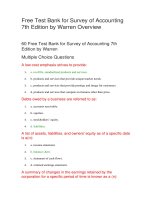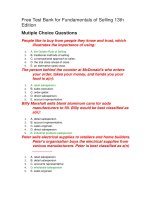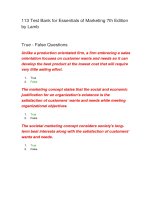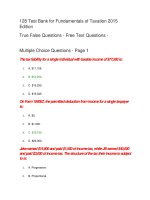fundamentals of biostatistics (7th edition)
Bạn đang xem bản rút gọn của tài liệu. Xem và tải ngay bản đầy đủ của tài liệu tại đây (33.42 MB, 891 trang )
CHE-ROSNER-10-0205-0FM.indd 1 7/16/10 12:24:10 AM
Copyright 2010 Cengage Learning, Inc. All Rights Reserved. May not be copied, scanned, or duplicated, in whole or in part.
CHE-ROSNER-10-0205-0FM.indd 2 7/16/10 12:24:10 AM
Copyright 2010 Cengage Learning, Inc. All Rights Reserved. May not be copied, scanned, or duplicated, in whole or in part.
Harvard University
CHE-ROSNER-10-0205-0FM.indd 3 7/16/10 12:24:20 AM
Copyright 2010 Cengage Learning, Inc. All Rights Reserved. May not be copied, scanned, or duplicated, in whole or in part.
This is an electronic version of the print textbook. Due to electronic rights restrictions, some third party content may be suppressed.
Editorial review has deemed that any suppressed content does not materially affect the overall learning experience.
The publisher reserves the right to remove content from this title at any time if subsequent rights restrictions require it.
For valuable information on pricing, previous editions, changes to current editions, and alternate formats,
please visit www.cengage.com/highered to search by ISBN#, author, title, or keyword for materials in your areas of interest.
Copyright 2010 Cengage Learning, Inc. All Rights Reserved. May not be copied, scanned, or duplicated, in whole or in part.
© , Brooks/Cole, Cengage Learning
ALL RIGHTS RESERVED. No part of this work covered by the copyright
herein may be reproduced, transmitted, stored, or used in any form
or by any means graphic, electronic, or mechanical, including but not
limited to photocopying, recording, scanning, digitizing, taping, Web
distribution, information networks, or information storage and retrieval
systems, except as permitted under Section or of the
United States Copyright Act, without the prior written permission of the
publisher.
Library of Congress Control Number:
ISBN-: ----
ISBN-: ---
Brooks/Cole
Channel Center Street
Boston, MA
USA
Cengage Learning is a leading provider of customized learning solutions
with oce locations around the globe, including Singapore, the United
Kingdom, Australia, Mexico, Brazil and Japan. Locate your local oce at
international.cengage.com/region
Cengage Learning products are represented in Canada by
Nelson Education, Ltd.
For your course and learning solutions, visit www.cengage.com.
Purchase any of our products at your local college store or at our preferred
online store www.cengagebrain.com.
Fundamentals of Biostatistics
Seventh Edition
Rosner
Senior Sponsoring Editor: Molly Taylor
Associate Editor: Daniel Seibert
Editorial Assistant: Shaylin Walsh
Marketing Manager: Ashley Pickering
Marketing Coordinator: Erica O’Connell
Marketing Communications Manager:
Mary Anne Payumo
Content Project Manager: Jessica Rasile
Associate Media Editor: Andrew Coppola
Art Director: Linda Helcher
Senior Print Buyer: Diane Gibbons
Senior Rights Specialist: Katie Huha
Production Service/Composition: Cadmus
Cover Design: Pier One Design
Cover Images: ©Egorych/istockphoto,
©enot-poloskun/istockphoto,
©dem10/istockphoto,
©bcollet/istockphoto
Printed in Canada
1 2 3 4 5 6 7 14 13 12 11 10
For product information and technology assistance, contact us at
Cengage Learning Customer & Sales Support, 1-800-354-9706
For permission to use material from this text or product,
submit all requests online at www.cengage.com/permissions.
Further permissions questions can be emailed to
CHE-ROSNER-10-0205-0FM.indd 4 7/16/10 12:24:21 AM
Copyright 2010 Cengage Learning, Inc. All Rights Reserved. May not be copied, scanned, or duplicated, in whole or in part.
This book is dedicated to my wife, Cynthia,
and my children, Sarah, David, and Laura
CHE-ROSNER-10-0205-0FM.indd 5 7/16/10 12:24:21 AM
Copyright 2010 Cengage Learning, Inc. All Rights Reserved. May not be copied, scanned, or duplicated, in whole or in part.
CHE-ROSNER-10-0205-0FM.indd 6 7/16/10 12:24:21 AM
Copyright 2010 Cengage Learning, Inc. All Rights Reserved. May not be copied, scanned, or duplicated, in whole or in part.
vii
*The new sections and the expanded sections for this edition are indicated by an asterisk.
CHE-ROSNER-10-0205-0FM.indd 7 7/16/10 12:24:21 AM
Copyright 2010 Cengage Learning, Inc. All Rights Reserved. May not be copied, scanned, or duplicated, in whole or in part.
Nµσ
N
CHE-ROSNER-10-0205-0FM.indd 8 7/16/10 12:24:21 AM
Copyright 2010 Cengage Learning, Inc. All Rights Reserved. May not be copied, scanned, or duplicated, in whole or in part.
χ
t
t
t
CHE-ROSNER-10-0205-0FM.indd 9 7/16/10 12:24:21 AM
Copyright 2010 Cengage Learning, Inc. All Rights Reserved. May not be copied, scanned, or duplicated, in whole or in part.
R× C
CHE-ROSNER-10-0205-0FM.indd 10 7/16/10 12:24:21 AM
Copyright 2010 Cengage Learning, Inc. All Rights Reserved. May not be copied, scanned, or duplicated, in whole or in part.
CHE-ROSNER-10-0205-0FM.indd 11 7/16/10 12:24:21 AM
Copyright 2010 Cengage Learning, Inc. All Rights Reserved. May not be copied, scanned, or duplicated, in whole or in part.
Pr Xk
n
k
pq
knk
=
(
)
=
−
Pr Xk
e
k
k
=
(
)
=
−µ
µ
!
tt
d,u
χ
d,u
×αα
×αα
µ
FF
d
,d
,p
n,α
α
z
r
s
H
k
qα
CHE-ROSNER-10-0205-0FM.indd 12 7/16/10 12:24:22 AM
Copyright 2010 Cengage Learning, Inc. All Rights Reserved. May not be copied, scanned, or duplicated, in whole or in part.
his introductory-level biostatistics text is designed for upper-level undergraduate
or graduate students interested in medicine or other health-related areas. It requires
no previous background in statistics, and its mathematical level assumes only a
knowledge of algebra.
Fundamentals of Biostatistics evolved from notes that I have used in a biostatistics
course taught to Harvard University undergraduates and Harvard Medical School
students over the past 30 years. I wrote this book to help motivate students to mas-
ter the statistical methods that are most often used in the medical literature. From
the student’s viewpoint, it is important that the example material used to develop
these methods is representative of what actually exists in the literature. Therefore,
most of the examples and exercises in this book are based either on actual articles
from the medical literature or on actual medical research problems I have encoun-
tered during my consulting experience at the Harvard Medical School.
Most introductory statistics texts either use a completely nonmathematical, cookbook
approach or develop the material in a rigorous, sophisticated mathematical frame-
work. In this book, however, I follow an intermediate course, minimizing the amount
of mathematical formulation but giving complete explanations of all the important
concepts. Every new concept in this book is developed systematically through com-
pletely worked-out examples from current medical research problems. In addition, I
introduce computer output where appropriate to illustrate these concepts.
I initially wrote this text for the introductory biostatistics course. However, the
field has changed rapidly over the past 10 years; because of the increased power of
newer statistical packages, we can now perform more sophisticated data analyses than
ever before. Therefore, a second goal of this text is to present these new techniques at
an introductory level so that students can become familiar with them without having
to wade through specialized (and, usually, more advanced) statistical texts.
To differentiate these two goals more clearly, I included most of the content for
the introductory course in the first 12 chapters. More advanced statistical techniques
used in recent epidemiologic studies are covered in Chapter 13, “Design and Analysis
Techniques for Epidemiologic Studies” and Chapter 14, “Hypothesis Testing: Person-
Time Data.”
xiii
CHE-ROSNER-10-0205-0FM.indd 13 7/16/10 12:24:22 AM
Copyright 2010 Cengage Learning, Inc. All Rights Reserved. May not be copied, scanned, or duplicated, in whole or in part.
For this edition, I have added seven new sections and added new content to one
other section. Features new to this edition include the following:
■ The data sets are now available on the book’s Companion Website at www
.cengage.com/statistics/rosner in an expanded set of formats, including Excel,
Minitab
®
, SPSS, JMP, SAS, Stata, R, and ASCII formats.
■ Data and medical research findings in Examples have been updated.
■ New or expanded coverage of the following topics:
■ Interval estimates for rank correlation coefficients (Section 11.13)
■ Mixed effect models (Section 12.10)
■ Attributable risk (Section 13.4)
■ Extensions to logistic regression (Section 13.9)
■ Regression models for clustered binary data (Section 13.13)
■ Longitudinal data analysis (Section 13.14)
■ Parametric survival analysis (Section 14.13)
■ Parametric regression models for survival data (Section 14.14)
The new sections and the expanded sections for this edition have been indicated by
an asterisk in the table of contents.
This edition contains 1438 exercises; 244 of these exercises are new. Data and medical
research findings in the problems have been updated where appropriate. All problems
based on the data sets are included. Problems marked by an asterisk (*) at the end of
each chapter have corresponding brief solutions in the answer section at the back of
the book. Based on requests from students for more completely solved problems, ap-
proximately 600 additional problems and complete solutions are presented in the
Study Guide available on the Companion Website accompanying this text. In addition,
approximately 100 of these problems are included in a Miscellaneous Problems section
and are randomly ordered so that they are not tied to a specific chapter in the book.
This gives the student additional practice in determining what method to use in what
situation. Complete instructor solutions to all exercises are available in secure online
format through Cengage’s Solution Builder service. Adopting instructors can sign up for
access at www.cengage.com/solutionbuilder.
The method of handling computations is similar to that used in the sixth edition. All
intermediate results are carried to full precision (10+ significant digits), even though
they are presented with fewer significant digits (usually 2 or 3) in the text. Thus,
intermediate results may seem inconsistent with final results in some instances; this,
however, is not the case.
Fundamentals of Biostatistics, Seventh Edition, is organized as follows.
Chapter 1 is an introductory chapter that contains an outline of the develop-
ment of an actual medical study with which I was involved. It provides a unique
sense of the role of biostatistics in medical research.
Chapter 2 concerns descriptive statistics and presents all the major numeric and
graphic tools used for displaying medical data. This chapter is especially important
CHE-ROSNER-10-0205-0FM.indd 14 7/16/10 12:24:22 AM
Copyright 2010 Cengage Learning, Inc. All Rights Reserved. May not be copied, scanned, or duplicated, in whole or in part.
for both consumers and producers of medical literature because much information
is actually communicated via descriptive material.
Chapters 3 through 5 discuss probability. The basic principles of probability are
developed, and the most common probability distributions—such as the binomial
and normal distributions—are introduced. These distributions are used extensively
in later chapters of the book. The concepts of prior probability and posterior prob-
ability are also introduced.
Chapters 6 through 10 cover some of the basic methods of statistical inference.
Chapter 6 introduces the concept of drawing random samples from popula-
tions. The difficult notion of a sampling distribution is developed and includes an
introduction to the most common sampling distributions, such as the t and chi-
square distributions. The basic methods of estimation, including an extensive discus-
sion of confidence intervals, are also presented.
Chapters 7 and 8 contain the basic principles of hypothesis testing. The most
elementary hypothesis tests for normally distributed data, such as the t test, are also
fully discussed for one- and two-sample problems. The fundamentals of Bayesian
inference are explored.
Chapter 9 covers the basic principles of nonparametric statistics. The assump-
tions of normality are relaxed, and distribution-free analogues are developed for the
tests in Chapters 7 and 8.
Chapter 10 contains the basic concepts of hypothesis testing as applied to cat-
egorical data, including some of the most widely used statistical procedures, such as
the chi-square test and Fisher’s exact test.
Chapter 11 develops the principles of regression analysis. The case of simple lin-
ear regression is thoroughly covered, and extensions are provided for the multiple-
regression case. Important sections on goodness-of-fit of regression models are also
included. Also, rank correlation is introduced. Interval estimates for rank correlation
coefficients are covered for the first time. Methods for comparing correlation coef-
ficients from dependent samples are also included.
Chapter 12 introduces the basic principles of the analysis of variance (ANOVA).
The one-way analysis of variance fixed- and random-effects models are discussed. In
addition, two-way ANOVA, the analysis of covariance, and mixed effects models are
covered. Finally, we discuss nonparametric approaches to one-way ANOVA. Multiple
comparison methods including material on the false discovery rate are also provided.
A section of mixed models is also included for the first time.
Chapter 13 discusses methods of design and analysis for epidemiologic studies.
The most important study designs, including the prospective study, the case– control
study, the cross-sectional study, and the cross-over design are introduced. The con-
cept of a confounding variable—that is, a variable related to both the disease and
the exposure variable—is introduced, and methods for controlling for confound-
ing, which include the Mantel-Haenszel test and multiple-logistic regression, are
discussed in detail. Extensions to logistic regression models, including conditional
logistic regression, polytomous logistic regression, and ordinal logistic regression,
are discussed for the first time. This discussion is followed by the exploration of
topics of current interest in epidemiologic data analysis, including meta-analysis
(the combination of results from more than one study); correlated binary data tech-
niques (techniques that can be applied when replicate measures, such as data from
multiple teeth from the same person, are available for an individual); measurement
error methods (useful when there is substantial measurement error in the exposure
data collected); equivalence studies (whose objective it is to establish bioequivalence
between two treatment modalities rather than that one treatment is superior to the
other); and missing-data methods for how to handle missing data in epidemiologic
CHE-ROSNER-10-0205-0FM.indd 15 7/16/10 12:24:22 AM
Copyright 2010 Cengage Learning, Inc. All Rights Reserved. May not be copied, scanned, or duplicated, in whole or in part.
studies. Longitudinal data analysis and generalized estimating equation (GEE) meth-
ods are also briefly discussed.
Chapter 14 introduces methods of analysis for person-time data. The methods
covered in this chapter include those for incidence-rate data, as well as several meth-
ods of survival analysis: the Kaplan-Meier survival curve estimator, the log-rank test,
and the proportional-hazards model. Methods for testing the assumptions of the
proportional-hazards model have also been included. Parametric survival analysis
methods are covered for the first time.
Throughout the text—particularly in Chapter 13—I discuss the elements of
study designs, including the concepts of matching; cohort studies; case–control
studies; retrospective studies; prospective studies; and the sensitivity, specificity, and
predictive value of screening tests. These designs are presented in the context of ac-
tual samples. In addition, Chapters 7, 8, 10, 11, 13, and 14 contain specific sections
on sample-size estimation for different statistical situations.
A flowchart of appropriate methods of statistical inference (see pages 841–846)
is a handy reference guide to the methods developed in this book. Page references
for each major method presented in the text are also provided. In Chapters 7–8 and
Chapters 10–14, I refer students to this flowchart to give them some perspective on
how the methods discussed in a given chapter fit with all the other statistical meth-
ods introduced in this book.
In addition, I have provided an index of applications, grouped by medical spe-
cialty, summarizing all the examples and problems this book covers.
I am indebted to Debra Sheldon, the late Marie Sheehan, and Harry Taplin for their
invaluable help typing the manuscript, to Dale Rinkel for invaluable help in typing
problem solutions, and to Marion McPhee for helping to prepare the data sets on the
Companion Website. I am also indebted to Brian Claggett for updating solutions to
problems for this edition, and to Daad Abraham for typing the Index of Applications.
In addition, I wish to thank the manuscript reviewers, among them: Emilia Bagiella,
Columbia University; Ron Brookmeyer, Johns Hopkins University; Mark van der Laan,
University of California, Berkeley; and John Wilson, University of Pittsburgh. I would
also like to thank my colleagues Nancy Cook, who was instrumental in helping me de-
velop the part of Section 12.4 on the false-discovery rate, and Robert Glynn, who was
instrumental in developing Section 13.16 on missing data and Section 14.11 on testing
the assumptions of the proportional-hazards model.
In addition, I wish to thank Molly Taylor, Daniel Seibert, Shaylin Walsh, and
Laura Wheel, who were instrumental in providing editorial advice and in preparing
the manuscript.
I am also indebted to my colleagues at the Channing Laboratory—most notably,
the late Edward Kass, Frank Speizer, Charles Hennekens, the late Frank Polk, Ira Tager,
Jerome Klein, James Taylor, Stephen Zinner, Scott Weiss, Frank Sacks, Walter Willett,
Alvaro Munoz, Graham Colditz, and Susan Hankinson—and to my other colleagues at
the Harvard Medical School, most notably, the late Frederick Mosteller, Eliot Berson,
Robert Ackerman, Mark Abelson, Arthur Garvey, Leo Chylack, Eugene Braunwald, and
Arthur Dempster, who inspired me to write this book. I also wish to acknowledge John
Hopper and Philip Landrigan for providing the data for our case studies.
Finally, I would like to acknowledge Leslie Miller, Andrea Wagner, Loren Fish-
man, and Frank Santopietro, without whose clinical help the current edition of this
book would not have been possible.
Bernard Rosner
CHE-ROSNER-10-0205-0FM.indd 16 7/16/10 12:24:22 AM
Copyright 2010 Cengage Learning, Inc. All Rights Reserved. May not be copied, scanned, or duplicated, in whole or in part.
Bernard Rosner is Professor of Medicine (Biostatistics)
at Harvard Medical School and Professor of Biosta-
tistics in the Harvard School of Public Health. He
received a B.A. in Mathematics from Columbia Uni-
versity in 1967, an M.S. in Statistics from Stanford
University in 1968, and a Ph.D. in Statistics from Har-
vard University in 1971.
He has more than 30 years of biostatistical con-
sulting experience with other investigators at the Har-
vard Medical School. Special areas of interest include
cardio vascular disease, hypertension, breast cancer,
and ophthalmology. Many of the examples and exer-
cises used in the text reflect data collected from actual
studies in conjunction with his consulting experience.
In addition, he has developed new biostatistical meth-
ods, mainly in the areas of longitudinal data analysis,
analysis of clustered data (such as data collected in
families or from paired organ systems in the same
person), measurement error methods, and outlier de-
tection methods. You will see some of these methods
introduced in this book at an elementary level. He was
married in 1972 to his wife, Cynthia, and has three
children, Sarah, David, and Laura, each of whom has
contributed examples for this book.
xvii
CHE-ROSNER-10-0205-0FM.indd 17 7/16/10 12:24:23 AM
Copyright 2010 Cengage Learning, Inc. All Rights Reserved. May not be copied, scanned, or duplicated, in whole or in part.
CHE-ROSNER-10-0205-0FM.indd 18 7/16/10 12:24:23 AM
Copyright 2010 Cengage Learning, Inc. All Rights Reserved. May not be copied, scanned, or duplicated, in whole or in part.
1
1
Statistics is the science whereby inferences are made about specific random phe-
nomena on the basis of relatively limited sample material. The field of statistics
has two main areas: mathematical statistics and applied statistics. Mathematical
statistics concerns the development of new methods of statistical inference and
requires detailed knowledge of abstract mathematics for its implementation.
Applied statistics involves applying the methods of mathematical statistics to specific
subject areas, such as economics, psychology, and public health. Biostatistics is the
branch of applied statistics that applies statistical methods to medical and biological
problems. Of course, these areas of statistics overlap somewhat. For example, in some
instances, given a certain biostatistical application, standard methods do not apply
and must be modified. In this circumstance, biostatisticians are involved in developing
new methods.
A good way to learn about biostatistics and its role in the research process is to
follow the flow of a research study from its inception at the planning stage to its com-
pletion, which usually occurs when a manuscript reporting the results of the study
is published. As an example, I will describe one such study in which I participated.
A friend called one morning and in the course of our conversation mentioned
that he had recently used a new, automated blood-pressure measuring device of the
type seen in many banks, hotels, and department stores. The machine had measured
his average diastolic blood pressure on several occasions as 115 mm Hg; the highest
reading was 130 mm Hg. I was very worried, because if these readings were accurate,
my friend might be in imminent danger of having a stroke or developing some other
serious cardiovascular disease. I referred him to a clinical colleague of mine who,
using a standard blood-pressure cuff, measured my friend’s diastolic blood pressure
as 90 mm Hg. The contrast in readings aroused my interest, and I began to jot down
readings from the digital display every time I passed the machine at my local bank.
I got the distinct impression that a large percentage of the reported readings were in
the hypertensive range. Although one would expect hypertensive individuals to be
more likely to use such a machine, I still believed that blood-pressure readings from
the machine might not be comparable with those obtained using standard methods
of blood-pressure measurement. I spoke with Dr. B. Frank Polk, a physician at Harvard
Medical School with an interest in hypertension, about my suspicion and succeeded
in interesting him in a small-scale evaluation of such machines. We decided to send a
human observer, who was well trained in blood-pressure measurement techniques, to
several of these machines. He would offer to pay participants 50¢ for the cost of using
the machine if they would agree to fill out a short questionnaire and have their blood
pressure measured by both a human observer and the machine.
General Overview
CHE-ROSNER-10-0205-001.indd 1 7/14/10 11:43:06 AM
Copyright 2010 Cengage Learning, Inc. All Rights Reserved. May not be copied, scanned, or duplicated, in whole or in part.
C H A P T E R 1
■
General Overview
At this stage we had to make several important decisions, each of which proved
vital to the success of the study. These decisions were based on the following
questions:
(1) How many machines should we test?
(2) How many participants should we test at each machine?
(3) In what order should we take the measurements? That is, should the human
observer or the machine take the first measurement? Under ideal circumstances
we would have taken both the human and machine readings simultaneously,
but this was logistically impossible.
(4) What data should we collect on the questionnaire that might influence the
comparison between methods?
(5) How should we record the data to facilitate computerization later?
(6) How should we check the accuracy of the computerized data?
We resolved these problems as follows:
(1) and (2) Because we were not sure whether all blood-pressure machines were
comparable in quality, we decided to test four of them. However, we wanted to
sample enough subjects from each machine so as to obtain an accurate comparison
of the standard and automated methods for each machine. We tried to predict how
large a discrepancy there might be between the two methods. Using the methods of
sample-size determination discussed in this book, we calculated that we would need
100 participants at each site to make an accurate comparison.
(3) We then had to decide in what order to take the measurements for each
person. According to some reports, one problem with obtaining repeated blood-
pressure measurements is that people tense up during the initial measurement,
yielding higher blood pressure readings during subsequent measurements. Thus we
would not always want to use either the automated or manual method first, because
the effect of the method would get confused with the order-of-measurement
effect. A conventional technique we used here was to randomize the order in which
the measurements were taken, so that for any person it was equally likely that the
machine or the human observer would take the first measurement. This random
pattern could be implemented by flipping a coin or, more likely, by using a table of
random numbers similar to Table 4 of the Appendix.
(4) We believed that the major extraneous factor that might influence the results
would be body size (we might have more difficulty getting accurate readings from
people with fatter arms than from those with leaner arms). We also wanted to get
some idea of the type of people who use these machines. Thus we asked questions
about age, sex, and previous hypertension history.
(5) To record the data, we developed a coding form that could be filled out on
site and from which data could be easily entered into a computer for subsequent
analysis. Each person in the study was assigned a unique identification (ID) number
by which the computer could identify that person. The data on the coding forms
were then keyed and verified. That is, the same form was entered twice and the two
records compared to make sure they were the same. If the records did not match, the
form was re-entered.
(6) Checking each item on each form was impossible because of the large
amount of data involved. Instead, after data entry we ran some editing programs
to ensure that the data were accurate. These programs checked that the values for
CHE-ROSNER-10-0205-001.indd 2 7/14/10 11:43:06 AM
Copyright 2010 Cengage Learning, Inc. All Rights Reserved. May not be copied, scanned, or duplicated, in whole or in part.
General Overview
individual variables fell within specified ranges and printed out aberrant values for
manual checking. For example, we checked that all blood-pressure readings were at
least 50 mm Hg and no higher than 300 mm Hg, and we printed out all readings
that fell outside this range.
After completing the data-collection, data-entry, and data-editing phases, we were
ready to look at the results of the study. The first step in this process is to get an im-
pression of the data by summarizing the information in the form of several descrip-
tive statistics. This descriptive material can be numeric or graphic. If numeric, it can
be in the form of a few summary statistics, which can be presented in tabular form
or, alternatively, in the form of a frequency distribution, which lists each value in
the data and how frequently it occurs. If graphic, the data are summarized pictori-
ally and can be presented in one or more figures. The appropriate type of descriptive
material to use varies with the type of distribution considered. If the distribution is
continuous—that is, if there are essentially an infinite number of possible values, as
would be the case for blood pressure—then means and standard deviations may be
the appropriate descriptive statistics. However, if the distribution is discrete—that is,
if there are only a few possible values, as would be the case for sex—then percentages
of people taking on each value are the appropriate descriptive measure. In some cases
both types of descriptive statistics are used for continuous distributions by condens-
ing the range of possible values into a few groups and giving the percentage of people
that fall into each group (e.g., the percentages of people who have blood pressures
between 120 and 129 mm Hg, between 130 and 139 mm Hg, and so on).
In this study we decided first to look at mean blood pressure for each method at
each of the four sites. Table 1.1 summarizes this information [1].
You may notice from this table that we did not obtain meaningful data from
all 100 people interviewed at each site. This was because we could not obtain valid
readings from the machine for many of the people. This problem of missing data is
very common in biostatistics and should be anticipated at the planning stage when
deciding on sample size (which was not done in this study).
Our next step in the study was to determine whether the apparent differences in
blood pressure between machine and human measurements at two of the locations
(C, D) were “real” in some sense or were “due to chance.” This type of question falls
into the area of inferential statistics. We realized that although there was a differ-
ence of 14 mm Hg in mean systolic blood pressure between the two methods for
the 98 people we interviewed at location C, this difference might not hold up if we
Mean blood pressures and differences between machine
and human readings at four locations
Location
Number
of people
Systolic blood pressure (mm Hg)
Machine Human Difference
Mean
Standard
deviation
Mean
Standard
deviation
Mean
Standard
deviation
A 98 142.5 21.0 142.0 18.1 0.5 11.2
B 84 134.1 22.5 133.6 23.2 0.5 12.1
C 98 147.9 20.3 133.9 18.3 14.0 11.7
D 62 135.4 16.7 128.5 19.0 6.9 13.6
Source: By permission of the American Heart Association, Inc.
CHE-ROSNER-10-0205-001.indd 3 7/14/10 11:43:06 AM
Copyright 2010 Cengage Learning, Inc. All Rights Reserved. May not be copied, scanned, or duplicated, in whole or in part.
C H A P T E R 1
■
General Overview
interviewed 98 other people at this location at a different time, and we wanted to
have some idea as to the error in the estimate of 14 mm Hg. In statistical jargon,
this group of 98 people represents a sample from the population of all people who
might use that machine. We were interested in the population, and we wanted to
use the sample to help us learn something about the population. In particular, we
wanted to know how different the estimated mean difference of 14 mm Hg in our
sample was likely to be from the true mean difference in the population of all peo-
ple who might use this machine. More specifically, we wanted to know if it was still
possible that there was no underlying difference between the two methods and that
our results were due to chance. The 14-mm Hg difference in our group of 98 people
is referred to as an estimate of the true mean difference (d) in the population. The
problem of inferring characteristics of a population from a sample is the central con-
cern of statistical inference and is a major topic in this text. To accomplish this aim,
we needed to develop a probability model, which would tell us how likely it is that
we would obtain a 14-mm Hg difference between the two methods in a sample of
98 people if there were no real difference between the two methods over the entire
population of users of the machine. If this probability were small enough, then we
would begin to believe a real difference existed between the two methods. In this
particular case, using a probability model based on the t distribution, we concluded
this probability was less than 1 in 1000 for each of machines at locations C and D.
This probability was sufficiently small for us to conclude there was a real difference
between the automatic and manual methods of measuring blood pressure for two of
the four machines tested.
We used a statistical package to perform the preceding data analyses. A package
is a collection of statistical programs that describe data and perform various statisti-
cal tests on the data. Currently the most widely used statistical packages are SAS,
SPSS, Stata, MINITAB, and Excel.
The final step in this study, after completing the data analysis, was to compile
the results in a publishable manuscript. Inevitably, because of space considerations,
we weeded out much of the material developed during the data-analysis phase and
presented only the essential items for publication.
This review of our blood-pressure study should give you some idea of what
medical research is about and the role of biostatistics in this process. The material in
this text parallels the description of the data-analysis phase of the study. Chapter 2
summarizes different types of descriptive statistics. Chapters 3 through 5 present
some basic principles of probability and various probability models for use in later
discussions of inferential statistics. Chapters 6 through 14 discuss the major topics
of inferential statistics as used in biomedical practice. Issues of study design or data
collection are brought up only as they relate to other topics discussed in the text.
[1] Polk, B. F., Rosner, B., Feudo, R., & Vandenburgh, M.
(1980). An evaluation of the Vita-Stat automatic blood pres-
sure measuring device. Hypertension, 2(2), 221−227.
CHE-ROSNER-10-0205-001.indd 4 7/14/10 11:43:07 AM
Copyright 2010 Cengage Learning, Inc. All Rights Reserved. May not be copied, scanned, or duplicated, in whole or in part.
5
2
2.1 Introduction
The first step in looking at data is to describe the data at hand in some concise way.
In smaller studies this step can be accomplished by listing each data point. In gen-
eral, however, this procedure is tedious or impossible and, even if it were possible,
would not give an overall picture of what the data look like.
Cancer, Nutrition Some investigators have proposed that consumption of vitamin A
prevents cancer. To test this theory, a dietary questionnaire might be used to collect
data on vitamin-A consumption among 200 hospitalized cancer patients (cases) and
200 controls. The controls would be matched with regard to age and sex with the
cancer cases and would be in the hospital at the same time for an unrelated disease.
What should be done with these data after they are collected?
Before any formal attempt to answer this question can be made, the vitamin-A
consumption among cases and controls must be described. Consider Figure 2.1. The
bar graphs show that the controls consume more vitamin A than the cases do, par-
ticularly at consumption levels exceeding the Recommended Daily Allowance (RDA).
Pulmonary Disease Medical researchers have often suspected that passive smokers—
people who themselves do not smoke but who live or work in an environment in
which others smoke—might have impaired pulmonary function as a result. In 1980
a research group in San Diego published results indicating that passive smokers did
indeed have significantly lower pulmonary function than comparable nonsmokers
who did not work in smoky environments [1]. As supporting evidence, the authors
measured the carbon-monoxide (CO) concentrations in the working environments
of passive smokers and of nonsmokers whose companies did not permit smoking in
the workplace to see if the relative CO concentration changed over the course of the
day. These results are displayed as a scatter plot in Figure 2.2.
Figure 2.2 clearly shows that the CO concentrations in the two working environ-
ments are about the same early in the day but diverge widely in the middle of the
day and then converge again after the workday is over at 7
p.m.
Graphic displays illustrate the important role of descriptive statistics, which
is to quickly display data to give the researcher a clue as to the principal trends in
the data and suggest hints as to where a more detailed look at the data, using the
Descriptive Statistics
CHE-ROSNER-10-0205-002.indd 5 7/16/10 11:06:36 AM
Copyright 2010 Cengage Learning, Inc. All Rights Reserved. May not be copied, scanned, or duplicated, in whole or in part.









